

What is Designated for Assignment (DFA) Mean in Baseball?
We are reader supported. When you purchase through links on our site, we may earn an affiliate commission. Also, as an Amazon affiliate, we earn from qualifying purchases.
Of all the distinctive terms used in Major League Baseball, “Designated for assignment” must be near the top of the list for the hardest to explain to new fans. When a player is declared this, often stated as “He was DFA’d,” what exactly does it mean?
Designated for assignment refers to a player’s contract, and it means the team will immediately remove that player from its 40-man roster. For MLB fans, it means you will no longer be seeing that player on that team, at least for a decent spell.
Typically MLB teams do this to clear space for another move, or simply to rid a player from the squad entirely.
Once a player is officially DFA’d, a 7-day period begins, where the club must make a decision about the next destination for that player. In other words, it’s a way for baseball teams to put a player in temporary limbo while they try to figure out their roster situation.
During the 7-day period, that player can be sent to one of the team’s minor league affiliates; traded to another team; or placed on waivers, a list of players for other teams to acquire (under certain rules).
Basically, when you see this term attached to a player, that person is being moved off the regular MLB team at least for the time being. Sometimes, though not often, they are returned to their original team.
Baseball Club Options with Players Designated for Assignment
Once a player is DFA’d, the clock starts for the club to pick an option for that player’s immediate future. Those options are:
- Assign the player to one of a minor league team affiliated with the club. (This is not available for all players; see Common Questions at bottom).
- Place the player on the Waiver Wire . This move begins another type of clock ~ where other teams can take the player, under the league’s waiver rules.
2B. If the player on the waiver wire is claimed, his new team must immediately put him on their 40-man roster.
2C. If the player, over a specified period of time, is unclaimed from waivers, he can be assigned to his previous team’s minor league system. Unless: The player has enough service time in the major leagues, or has run out of minor league options (See below), in which case he becomes a free agent who can sign a contract with any team.
- The player could be released from his contract, that is, set entirely free to go play with any other team. In such instances, the club is responsible for paying the player according to the terms of their contract together.
Types of Rosters in Major League Baseball
All this talk assumes fans know what a 40-man roster is ~ and it’s not just the list of players the current MLB team can use for games. That would be the 26-man roster.
Here’s a breakdown of the 2 types of MLB rosters, which are essentially lists of their players who either can be used in games (26-man), or who are in line to play in games in the near future as well (40-man).
26-Man Roster in MLB
The 26-man roster (or 24- or 25-man rosters in seasons past) is for players available to participate in MLB game play. Players not on the 26-man roster, such as those on injured lists, or in the minor leagues, cannot be entered into an MLB game.
So, MLB teams cannot just sign anyone off the street and instantly insert them into a game. Well, maybe not instantaneously, but at least a full day. However, even that would involve some juggling of personnel, as noted in this article.
40-Man Roster in MLB

A club’s 40-man roster is filled by a combination of players on the 26-man roster; along with players on various injured lists (7-, 10-, and 15-day injured lists); on an emergency list for bereavement or a family medical emergency; and some minor league players.
All players on a 26-man roster are also on the 40-man roster. That leaves a club 14 spots to manage all year long ~ and not just during the regular season.
The 40-man roster is important to watch during the offseason , as all those players are protected from other teams “taking” them in what’s called the Rule 5 Draft, held at the end of every year during the MLB’s Winter Meetings.
Notes on the Rule 5 Draft in Major League Baseball
Since 1920, the Rule 5 Draft has given minor league players opportunities with new MLB clubs ~ if their original club did not protect them from this draft by keeping them on the 40-man roster.
The way it works is, clubs with a spot open on their own 40-man roster select players not on 40-man rosters of the other clubs. This ends up like the regular MLB draft, with teams selecting in reverse order of the standings the previous season.
Players are eligible for selection if they are not on their team’s 40-man roster at the time of the draft, and they have either spent 4 seasons in professional baseball after signing at age 19 or older; or spent 5 seasons in pro ball after signing at age 18 or younger.
Even when drafting an eligible player, it’s not over. The new team pays the player’s previous club $100,000, places the player on its 40-man roster, AND then must keep the player on the 26-man roster for the entire next season.
This last requirement makes selecting other team’s unprotected minor league players a true challenge, as they do not yet know if that player will succeed at the major league level. If not, the team pretty much loses a roster spot through season’s end, filled by a player who can hardly contribute.
If the new club takes that player off the 26-man roster, however, it has to offer to return him to his previous team for $50,000.
Perhaps the most famous Rule 5 case was that of Hall of Famer Roberto Clemente, signed by the Brooklyn Dodgers at age 19 and buried on their Montreal, Canada minor league team, where he got all of 155 at bats .
That didn’t fool Branch Rickey, the general manager of the Pittsburgh Pirates, who that winter selected Clemente in the Rule 5 Draft ~ and then had to keep him on the roster that next season even as he struggled as a young foreign player competing at the game’s highest level.
Eventually the Puerto Rican hero came around, and became one of the best outfielders of all time.
Why Does ‘Designated for Assignment’ in Baseball Have to be So Complicated?
This all may seem confusing, but this system of using players in MLB game play, and also having extra players in case of injuries or emergencies, has evolved with the game. It’s a necessary structure that MLB clubs agree to abide by, for a lot of reasons, avoiding mayhem among them.
When a new fan sees these types of terms, usually in the agate type or side notes in sports sections, or sometimes added to the end of game news reports, they should consider just how hard it is to field a professional baseball team on a near-daily basis.
Baseball might look leisurely to play, but in reality the players exert parts of their body quite extensively ~ in some instances beyond what they are capable of naturally. A summary of a baseball player’s body that could force him off the field at any time:
- Arms . This includes shoulders, elbows, wrists, and fingers ~ all essential for baseball players to compete at all. The shoulders and elbows, in particular, are punished by the act of throwing a 5-ounce ball repeatedly over extended periods of time.
- Legs . Baseball is not a game of constant motion like the other major team sports. There is a lot of very instant starting, and quick stopping, which puts a lot of pressure on the tendons, ligaments, and joints of the legs. Knees and ankles give baseball players trouble, due to the starting-stopping, plus a lot of twisting involved in hitting and throwing.
- Core . This includes the abdomen, hips, and upper thighs. Probably more than the other major team sports, baseball is very tough on the middle of the body , mainly due to all the twisting. Batting, in particular, requires a tremendous twist of the torso to get the bat through the hitting zone, which can impact many muscle groups, as well as the spine.
- Back . Baseball players are susceptible to back injuries, mainly due to either overextending, or under-stretching. Often it’s a combination of both.
Add to all that the mental aspect of living life (e.g. having a wife and family) while away from home for weeks at a time, and the constant stress of having to perform well to remain in the game (and make more money). All the games, practices, stress, travel, loneliness, and more, can take a toll on any ballplayer.
In summary, any of these body (and mind) areas can take a baseball player out of service, maybe just for a few days, or a few weeks, or even many months. You can tell how often players get hurt by the MLB’s types of injured lists: the 7-day, 15-day, and 60-day injured list.
Roster Management in Baseball
All this gets us to the people responsible for getting the best players possible on the field during any MLB game. It’s not as simple as sending out the same 9 guys day in and day out. Pitchers in particular cannot pitch every single day, so extra pitchers must be brought along.
Some players might hurt a body part, but not in a major way, so all they need is a bit of rest. In these instances, pro baseball teams need a bench full of replacement players waiting to get in the game.
There’s also some competitive strategy involved. Baseball clubs can make changes to their roster daily, so if they foresee a problem upcoming, they can make roster changes to address it. Examples:
- Lengthy road trips . A club seeing a long stretch of games away from home might carry an extra pitcher just for that period. When they return home, they might send that extra pitcher back to the high minor leagues.
- Opposition strengths and weaknesses. The MLB regular-season schedule can be quirky, and sometimes teams play the same squads, or groups of them (e.g. from the same division), repeatedly over a short period. Maybe a club manager sees a group of upcoming games where every team has a lot of left-handed pitchers. Then, he may choose to swap out left-handed hitters, and add in more righties, just for that period of time.
In other words, the managers (and general managers) of MLB teams are constantly tinkering with their rosters, for a lot of reasons. Terms like DFA exist to add structure to all of this, in an attempt to ensure fairness for all the clubs, and avoid anarchy.
In summary, the designated for assignment system exists so MLB teams can add a newly acquired player onto their roster ~ through a free agent signing, a trade, a waiver wire grab, or to pull a player up from a minor league team; or to address players bouncing between the injured lists.
Whenever a player is getting healthy enough to return, fans usually get quite excited. But understand, for every player returning to play, another is forced to leave.
Common Questions
Question: what is the difference between being designated for assign and being “optioned”.
Answer: Remaining on the 40-man roster, or not. To be optioned means a player on the 40-man roster is moved to an “optional assignment” with one of the club’s minor league affiliates. An “option” is good for an entire season; and players only get so many options before clubs can no longer send them to a minor league team for roster management purposes. With DFA, if a player has an option remaining, that is something the club could choose to do in the 7-day “decision” period.
Q.: Why do teams only get 7 days to decide what to do with DFA’d players?
A.: It’s according to the current Collective Bargaining Agreement (CBA), which is the operating structure of the MLB between clubs and players. This period is adjusted periodically upon agreement of a majority of owners and the players. For instance, in the CBA of 2012-16, the period was 10 days.
What does 'DFA' mean in baseball? It's not an endearing abbreviation.
Albert Pujols . David Ortiz. Alex Rodriguez. Manny Ramirez. Nelson Cruz. Robinson Cano. Justin Upton.
Ortiz is enshrined in the Baseball Hall of Fame. Pujols is a lock for the Hall. Cruz is a future candidate for Cooperstown. And all were former major league All-Stars.
What do they all have in common?
Each of them have been DFA'd during their major league baseball career.
Ultimately, it means the player is cut from a team. It's one of several transactions that can happen to an MLB player. But it's a more common process for players who are in the latter years of their career and in the middle of a contract.
MLB SALARIES: Baseball's top 25 highest-paid players in 2024
What does DFA mean in baseball?
Designated for assignment.
It's one of the more unique transaction types in baseball, where unlike being traded, the player is optioned to the minor leagues or simply cut from the roster.
What does being designated for assignment mean?
Teams are allowed to have 40 players on their roster, with 26 of them active on the major league roster. Over the course of the season, teams make roster moves, which sometimes involves cutting a player. In order to take someone off the 40-man roster, they must be designated for assignment.
MLB.com explains the process: "When a player's contract is designated for assignment — often abbreviated "DFA" — that player is immediately removed from his club's 40-man roster. Within seven days of the transaction (had been 10 days under the 2012-16 Collective Bargaining Agreement), the player can either be traded or placed on irrevocable outright waivers."
Can another team claim a DFA'd player?
Yes, any team can pick up a player off waivers. However, if that team claims the player, they would have to add the player to their 40-man roster.
More baseball fun facts
- What does BB mean in baseball?
- What does OPS mean?
- What was the longest baseball game?
- Who invented baseball?

Baseball Basics
Bits Of Baseball: What Does DFA Mean in Baseball
FACT-CHECKED BY
Sean Hunter

As with other sports, baseball has a language of its own. There is a lot of jargon and lingo that you will have to know to get the most out of any baseball game. One of these terms is DFA. So, what does DFA mean in baseball?
DFA is short for Designated for Assignment and is a contractual term used in the baseball realm. Essentially, it refers to when a player is eliminated from a team’s 40-man roster and placed on waivers for other teams to claim.
You may have heard about this if you follow the Major League games and subscribe to baseball news. Most recently, renowned player Alber Pujols was designated for assignment by the Angels, stunning many fans and followers. It was a surprising announcement that prompted many people to search for the true meaning and implications of FDAs in the baseball context.
Indeed, there is plenty to know about this three-letter abbreviation. Various components complicate this notion, making it difficult for those that are outside of the baseball business to wrap their heads around.
Understanding this, we have put together a comprehensive but succinct guide for your reference. Read on to find out all about this niche topic of DFA baseball!
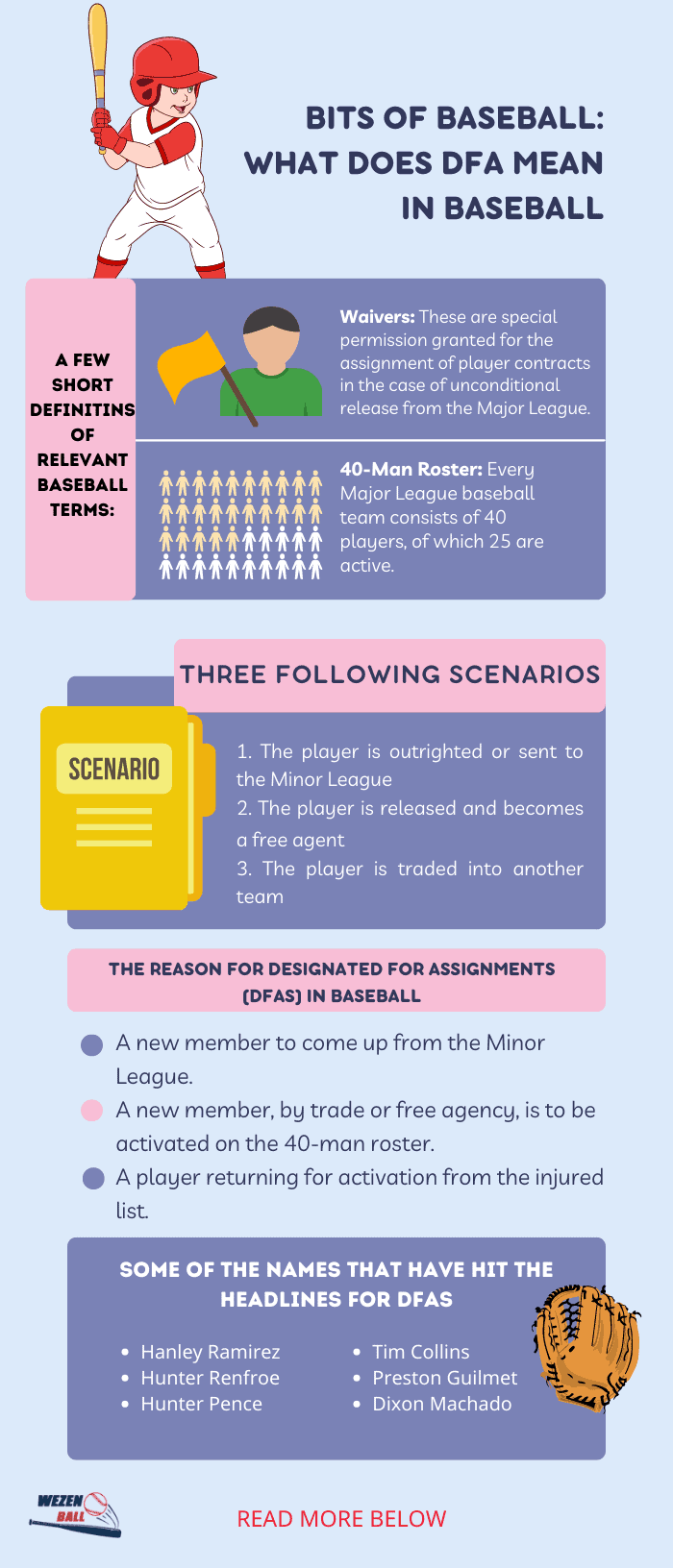
What Does DFA Mean in Baseball and the Technicalities Around DFA in Baseball
The reason for designated for assignments (dfas) in baseball.

To set the stage for explaining the technicalities around DFA (Designated for Assignment), here are a few short definitions of relevant baseball terms:
- Waivers: These are special permission granted for assignment of player contracts in the case of unconditional release from the Major League. Waivers are placed on players, who can be claimed by clubs and teams. Essentially, a waived player is up for grabs.
- 40-Man Roster: Every Major League baseball team consists of 40 players, of which 25 are active. The remaining players are still signed to contracts with that team but are on the injured list or take other spots in the team’s Minor League system.
Now that you have a basic idea of the lingo around this topic, we can delve into the detailed explanation of DFAs in baseball.
When a baseball player’s contract is set to be designated for assignment, the player is taken off his or her current club’s 40-man roster and placed on waivers. Within three business days, any other team can claim the player. When it comes to claims, the priority goes to the league, in which the player is already a part of.
For example, if a player is in the American League, other American teams can get dips on the player. Between two or more teams that want to claim the player, the team with the lower record gets to make the pickup. If a player is claimed before July 31st, the new team can take up his or her contract and the player will be automatically added to that team’s 40-man roster, or they can work out a trade with the original team.
Another possible scenario is the original team pulling the member back and off waivers, wherein the player returns to the 40-man roster, or is put on waivers again. But, the second time, the original team cannot revoke claims and will have to either give the player’s contract up to the new team or accept a trade.
If the player is not claimed after three days, his or her fate is decided by the original team. One of the three following scenarios will occur:
1. The player is outrighted or sent to the Minor League
2. The player is released and becomes a free agent
3. The player is traded into another team
But, at this point, there are a few other quite important aspects to note as well.
- A player can only be placed on waivers for the first seven days of a 10-day grace period. A player who has been outrighted is still paid the same amount on his/her guaranteed contract.
- A player can only be outrighted without consent once in his or her entire career.
- A player who has been in the Major League for more than five years cannot be outrighted without consent.
If a player, in this case, refuses to be outrighted, he or she has to be returned to the 40-man roster or released as a free agent. In the latter scenario, the player can sign with other teams and clubs on his or her own. The team that released him or her will have to cover the salary the player is owed minus what he or she is offered by the new team.
- Trades can only take place up until July 31st if waivers are not cleared.
- A player who has been in the Major League for 10 years and five years with his or her team cannot be traded without consent. This is also commonly referred to as the 10-and-5 rule.
When a player is on any 40-man roster, he or she will be granted three option years. Here, option means optional assignments. The player can be promoted to the Major League or demoted to the Minor League as many times as the parent club decides for three seasons.
Afterward, the player is out of options and he or she must be placed on waivers again. Once waivers are cleared, the player can be optioned back to the Minor League.
DFAs happen because a team may want to open a slot on their 40-man roster for:
1. A new member to come up from the Minor League
2. A new member, by trade or free agency, to be activated in the 40-man roster
3. A player returning for activation from the injured list
Simply put, when designating players for assignments, a team is making “roster room” for someone else to join their 40-man list.

Aside from the most recent DFAed player Alber Pujols, here are some of the names that have hit the headlines following announcements of DFAs:
- Hanley Ramirez
- Hunter Renfroe
- Hunter Pence
- Tim Collins
- Preston Guilmet
- Dixon Machado
You may have heard of these players, especially if you are a baseball enthusiast. For more, however, go through this tracker on MLB Trade Rumors.
So, there you have it! You have finished this article featuring the full answer to: “What does DFA mean in baseball?” Enjoy baseball games on TV and the headlines in a new light now that you have been enlightened! Hopefully, you were able to pick up a lot of valuable niche information.
If you have any other follow-up questions or thoughts regarding this, do not hesitate to leave a comment. We are always ready to hear from our readers. Also, share this article with your friends and family so they can learn about FDAs in baseball!

Five years as a baseball player, my training approaches with this game give me the motivation to inspire and support young players more. Like all sports, we should start with the desire to have fun and maintain our resilience to strive better at any competition. But, of course, some of us want to have some fun and train for better health. It does not matter what your initial purpose is; I believe that most people ever holding on to the baseball bat will fall in love with the games as I do.

How Long is a Baseball Bat in Feet? – Baseball Bat Length Guide
What Is the Rosin Bag Used for in Baseball? (Explained)

Recent Posts

Tips & Tricks
How Long is an Inning in Baseball?

How Many Players on a High School Baseball Team? Explained

What is Pool Play in Baseball? – Explained

How to Throw a Changeup Youth? (w/Tutorial Video)

What Channel is MLB Network on Spectrum?

What is a No-hitter in Baseball? – Explained

What is the Easiest Position in Baseball?

Batting Gloves
Baseball Knowledge: Where are Rawlings Baseball Gloves Made?
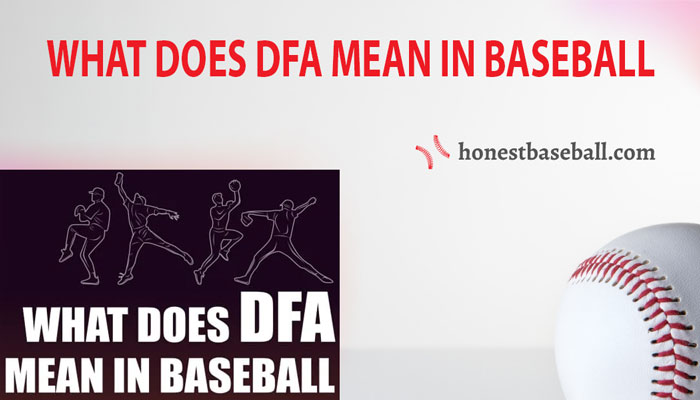
What Does Designate for Assignment (DFA) mean in Baseball?
Two days ago I was watching a TV show with my son. Actually, I was watching the show, and my son was busy with his iPhone. Suddenly, out of nowhere, he asked me, “Dad, What does DFA mean in Baseball?
My son is a teenager. So, it was not a “My father knows everything” type question. I am a baseball coach, and my Son is a die-hard supporter of the ‘Texas Rangers.’ Most probably, he was reading anything on Chris Gimenez.
Then I realized I hear this question quite often. That prompted me to write an article on this topic. As I operate a blog on baseball, why not answer the question on the blog? That will help many to know this large but important term of baseball.
Table of Contents
What does Designate for Assignment (DFA) mean in Major League Baseball?
First thing first, what is the full form of DFA? DFA means Designated for Assignment . When a player falls into this term, the team will immediately remove him from the 40-man roster. However, the team can replace that player with another one to fulfill its 40-player roster.
One crucial thing I should mention, DFA does not mean out-and-out release. Out and out release means permanently releasing a player, but if a player is DFAed, he has the chance to come back into the team.
Suppose you are completely new in this sector and trying to understand the entire scenario. Don’t be ashamed. I know how it feels when you don’t understand a term and google it because you are ashamed to ask someone about that. So, let’s start with the basics:
What is the 40-man roster?
40-man Roster – If you don’t know what does 40 man roster means, then let me clear it for you. In the major league service time, every team can sign 40 players. Among these 40 MLB players, 26 players are active. What happens to the rest 14 players? They play in the minor leagues or stay on the injured list.
What are Waivers?
In the previous section, you learned about the 40-man roster. So, now you can understand a team does not require all 40 players for the entire major league service time. Here come waivers handy.
Waivers give a player to play for any team. If a player gets a waiver, he is unconditionally free, and any team can take him in their team.
So, now you understand both the term ’40-man roster’ and ‘waiver.’ Now, it will be easy for me to clear the concept of DFA.
As I stated earlier, when a player is regarded as Designated for Assignment or DFA, he is immediately removed from the 40 man roaster. But that doesn’t make him a free agent. This means a DFAed player is not entirely released from the team.
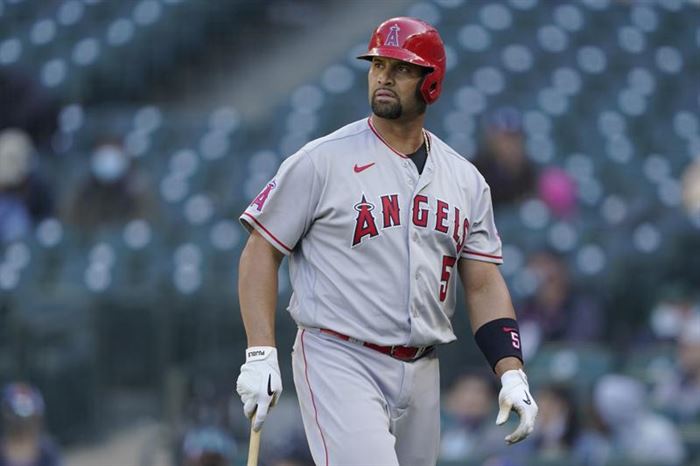
The team gets seven days to decide on the fate of the DFAed player. The team can trade the player, can place him on irrevocable outright waivers, or make him a free agent.
In case of a waiver, if the DFAed player clears waivers, he might be sent to the minors. There are two options in the case of waivers.
The player must provide his consent before sending to the minors if he has been playing MLB for five or more years. If he does not fall into that category, he will be immediately sent to the minors.
Why a player gets DFA while active in the Major League Service?
So, now you know what does DFA means in baseball. But what makes a player fall into DFA in the middle of a season? There could be many, but here I will tell you the top four reasons a player gets DFA.
- If the team wants to move in a minor league player into the team.
- If a player from the injured list recovers.
- If the team wants to trade a new player or free agent.
- If a team wants to clear a spot in the 40-man roster by a player recently added to the team via trade or free agency
Options for a Major League Baseball Team with a DFAed Player
Now, the most important question. What happens to the player who receives DFA? I have stated earlier a player is not immediately released if he has been DFA.
The team gets seven days to make a decision about the player before he is sent to the minor leagues.
Here are the things a team can do with the DFAed player within the seven days limit:
- Take back the player to its 40-player roster
- Most common practice – place the player on a waiver.
- Trade the player
- Make the player a free agent
- Send the player to the minor league (There is a player consent condition which I have stated earlier)
Let’s discuss some of the points in brief so that I don’t have to tell the same thing over and over to all.
Place the player on waivers
Placing in the waiver is the most common phenomenon for a DFA player. Though a team gets seven days limit to take any decision about the player, if the team wants to claim the waiver, they have to claim that within three days.
When a team waves a player, any team can claim him. But what happens when more than one team claims that player? In that case, the team (If the team is in the same league) with the lowest record will claim the player.
If the occurrence happens during the first month of the season, then the previous year’s standing is considered.
If no team from the same league claims the player and lower league teams claim, then the team with the highest record will claim the player.
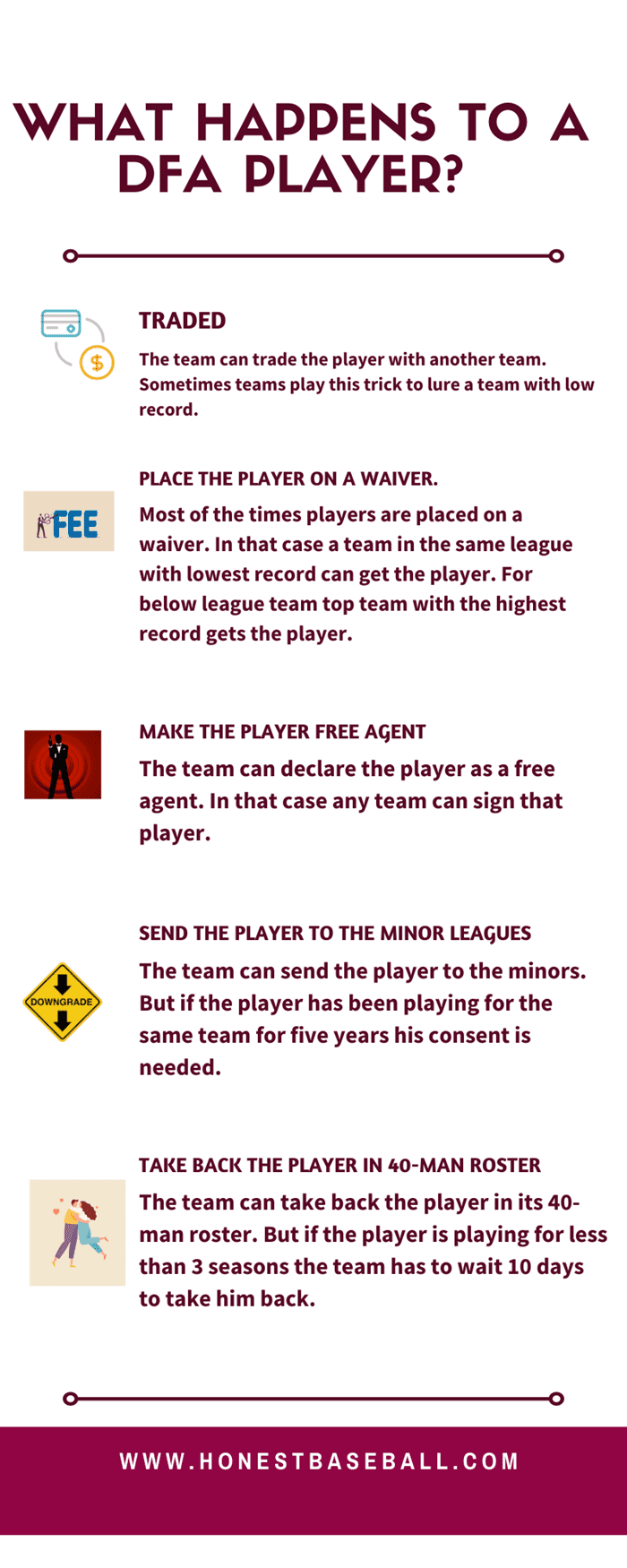
Trade the player
Trading the player with another team is another option for a team when a player is designated for DFA.
Sometimes teams imply DFA upon a player to lure a team that is not in a good position in the point table and pursues that team to buy that player.
For example, Rangers implied DFA on Brian Shouse in May 2006 and was traded to the Milwaukee Brewers 4 days later. The rangers didn’t put him in the waiver (remember, three days rule for the waiver?)
Because then 13 more other teams would have claimed for Brian Shouse. And there is another interesting rule called five to ten rules. According to the five to ten rule, if a player has been playing MLB for more than ten years and the last five years for the current team, he can not be traded without consent.
Release the player
When a DFA player is not traded nor waived, the team has to release him. The player becomes a free agent, and he is free to sign any team in the major league. On an interesting note, he can even sign the team just released him!
The team that releases him is responsible for the player’s salary, less what he is paid by the team that signs him.
Option a Baseball Player – What does it mean?
The term “Option” is related to the minor leagues. Let me give you the exact quotation from the baseball glossary
“An option allows that player to be sent to the Minor Leagues (“optioned”) without first being subjected to waivers.”
If a player is sent to the minor leagues he must clear waiver so that no team can put a waiver claim on that player.
Here a player is removed from the 26-man roster on which the main team is formed but keeps him in the ultimate 40-man roster.
If you are a baseball fan, then “sent down to the minors” or “optioned to the minor leagues” should be a familiar term to you. It means the club moves the player to the minors according to the eligibility.
If a player has 5 or more than 5 years of major league service time, he can be optioned and called back any time. But that is not the case; if the player has less than three years of service.
If a player with less than three years of service is optioned and sent to the minor leagues, the team can not call him immediately. The team has to wait at least ten days for that player if they want him to play again in the major league.
This rule is created to prevent constant back and forth major and minor league shuffling of players.
What Happens When Major League Player is Released?
I talked about this matter in a short scope earlier in this article. But sometimes, I asked this question, the difference between DFA and Release .
Release completely differs from the term DFA. Release means a player is out of the team, and there is no string attached between the player and the team.
A Release doesn’t happen in the middle of the season. It often happens in the offseason. It’s because there is a contract issue and that it is better to perform in the offseason. And by the spring training, most teams organize their team and decide which players will be in the roster spot.
When a team takes a 40-man roster decision, they have to make many decisions. The team management takes the decision on the 40-man roster and decides on the 26-man roster.

Major DFA incidents in the History of the Major League
Albert pujols.
The most recent incident of DFA is Albert Pujols which was also very shocking also. When Los Angels declared Alber Pujols designated for assignment in the last season of a 10-year contract .
Albert Pujols was one of the most prolific hitters in the history of the MLB. His highest batting average was .245 in 2016. But since then his form was declining. When he was DFAed, then his average was just .198.
Though he was one of the greatest players on the team, the team management had to take the tough decision. Angels team president John Carpino said,
“It never ends the way you want it to. This is baseball, and this is how it happens sometimes.”
Albert Pujols has won two world series championships and three league MVP awards. He was only the ninth player in the history of MLB to hit 600 career home runs. He was 41 years old when Los Angles took the decision to DFA him.
Chris Gimenez
Once Texas Rangers catcher Chris Gimenez was DFAed four times in his career. Teams he played for were Seattle mariners, Cleaveland Indians, Oakland Athletic.
He was finally DFAed frim Texas Rangers in 2014, and finally, Minnesota twins DFA him. He played in the minors and became a free agent a number of times. I was personally a fan of Chriz Gimenez, and the number of times teams implied DFA on him was really surprising to me.
Chris Young
Chirs Young was another player who was DFAed with a great record. In his career, he played for Red Sox, Los Angels, and Yankees.
Chris Young had a record of 25 base steals and 30 home runs in 2007. He was released after being DFAed from New Tork mates in 2014. The second DFA incident happened in 2017 after he joined Red Sox in 2015. He was declared a free agent in 2017.
Frequently Asked Questions
Why is it called designated for assignment.
DFA or Designated for Assignment is a different term used in baseball because here the team has various options. The team can place that player to waiver. In addition, the team can trade or send him to the minor leagues.
When a player is declared as designated for assignment, the team gets seven days window to make a decision. If they decide to waiver, they get three days to declare that. Otherwise, they can trade, release or send him to the minors. Moreover, if the team thinks they need that player again, they also can call him back to the team.
What does DFAed mean?
If a team declares DFA upon a player, we call that player DFAed. It’s just another expression of telling a team has imposed DFA on a player.
Is there any DFA in Minor Leagues?
No, DFA is a term used in the Major league. If a player DFAed he can be transferred to the minor leagues but there is no DFA in the minor leagues.
Conclusion
There are many abbreviations in baseball that baseball followers should know. ERA, Cycles, FPS , WHIP are some of them. DFA is less common among other abbreviations, but it is a vital abbreviation that every baseball fan should know.
Also, if you are a baseball fan, you should understand what happens to a DFA player. You should know options for both the player and the team. When Albert Pujols was DFAed, many baseball fans were confused about “what will happen now!” as they didn’t know the term.
As a coach, it’s my duty to make people understand the rules and terminology of baseball. These are the basics. When you follow a game, you should know the game from the inside.
So, what does DFA mean in baseball? I hope you won’t ask me this question next time you see me. Have a nice day, and I hope your favorite player never faces DFA in baseball.

Hello everyone. My name is Jason Butler, and I live in California, America. I was a professional AAA Minor League Baseball player. I lost my chance of playing MLB for injury issues, but I did not lose my love for baseball. I attended the coaching training program and am now working as a coach in a small school in San Diego.
I always love to share my experience and knowledge if that can help you. Play baseball, and stay fit.
Leave a Comment Cancel reply
Save my name, email, and website in this browser for the next time I comment.
- Skip to Navigation
- Skip to Main Content
- Skip to Related Content
- Today's news
- Climate change
- My portfolio
- My watchlist
- Stock market
- Biden economy
- Personal finance
- Stocks: most actives
- Stocks: gainers
- Stocks: losers
- Trending tickers
- World indices
- US Treasury bonds
- Top mutual funds
- Highest open interest
- Highest implied volatility
- Currency converter
- Basic materials
- Communication services
- Consumer cyclical
- Consumer defensive
- Financial services
- Industrials
- Real estate
- Mutual funds
- Credit card rates
- Balance transfer credit cards
- Business credit cards
- Cash back credit cards
- Rewards credit cards
- Travel credit cards
- Checking accounts
- Online checking accounts
- High-yield savings accounts
- Money market accounts
- Personal loans
- Student loans
- Car insurance
- Home buying
- Options pit
- Investment ideas
- Research reports
- Fantasy football
- Pro Pick 'Em
- College Pick 'Em
- Fantasy baseball
- Fantasy hockey
- Fantasy basketball
- Download the app
- Daily Fantasy
- Scores and schedules
- GameChannel
- World Baseball Classic
- Premier League
- CONCACAF League
- Champions League
- College football
- Horse racing
- Newsletters
Entertainment
- How To Watch
- Fall allergies
- Health news
- Mental health
- Sexual health
- Family health
- So mini ways
- Style and beauty
- Unapologetically
- Buying guides
- Privacy Dashboard
- March Madness
- Yahoo Sports AM
- Motorsports
- College Sports
- Fantasy Sports
- Horse Racing
- Scores/Schedules
- Power Rankings
- Fantasy Baseball
- World Series
- Diggs trade winners/losers
- Malachi Flynn drops 50
- Ohtani hits first Dodgers HR
- Caitlin Clark back-to-back POY
- Bears legend back in the hospital
What does designated for assignment mean in MLB? What to know about Madison Bumgarner
The Arizona Diamondbacks designated pitcher Madison Bumgarner for assignment on Thursday after his latest rough outing on Wednesday.
Bumgarner is 0-3 on the season with a 10.26 ERA in 16.2 innings over four starts. He has given up 25 hits and 19 earned runs, while walking 15 and striking out 10.
What's next for the pitcher and the Arizona Diamondbacks?
Here's a look at the designated for assignment process and what it means for Bumgarner and his MLB team.
What does designated for assignment (DFA) mean in baseball?
The MLB.com glossary explains the process as follows: "When a player's contract is designated for assignment — often abbreviated "DFA" — that player is immediately removed from his club's 40-man roster. Within seven days of the transaction (had been 10 days under the 2012-16 Collective Bargaining Agreement), the player can either be traded or placed on irrevocable outright waivers."
What happens if the player is claimed off waivers by another team?
The glossary explains the process as follows: "If the player is claimed off said waivers by another club, he is immediately added to that team's 40-man roster, at which point he can be optioned to the Minor Leagues (if he has Minor League options remaining) or assigned to his new team's 26-man roster. If the player clears waivers, he may be sent outright to the Minor Leagues or released. Players with more than three years of Major League service time or who have been previously outrighted may reject the outright assignment in favor of free agency. Clubs may utilize this option to clear a spot on the 40-man roster — typically with the intention of adding a newly acquired player (via trade or free agency), a Minor Leaguer or a player being activated from the 60-day injured list."
What are the specifics of Madison Bumgarner's DFA?
The Arizona Republic's Nick Piecoro explained the specifics regarding the situation for Bumgarner and the Diamondbacks in his story detailing the pitcher being designated for assignment on Thursday.
He wrote: "Bumgarner is likely to be placed on waivers soon, if he hasn't been already, and would become a free agent once he clears. He could then sign with another team for a prorated portion of the league minimum ($720,000). He is not likely to be claimed or traded given the amount of money still owed to him by the Diamondbacks."
How much do the Diamondbacks owe Madison Bumgarner?
Bumgarner signed a 5-year, $85 million contract with the Diamondbacks in December of 2019. He is still owed $34 million through next season. In cutting ties with Bumgarner, the Diamondbacks are setting a new club record for dead money, exceeding the $22 million they ate when releasing right-hander Russ Ortiz during the 2006 season.
More on Madison Bumgarner and the Diamondbacks
Madison Bumgarner designated for assignment by Diamondbacks
Why the Diamondbacks did not call up Brandon Pfaadt to replace Madison Bumgarner
With sense of urgency, Diamondbacks move on from struggling Madison Bumgarner
Arizona Diamondbacks fans sound off: Madison Bumgarner must be removed from rotation
Reach Jeremy Cluff at [email protected] . Follow him on Twitter @Jeremy_Cluff.
Support local journalism: Subscribe to azcentral.com today.
This article originally appeared on Arizona Republic: What does DFA mean in baseball? What's next for Madison Bumgarner
Designated For Assignment Meaning Baseball [DFA Explained]
By Salim Prajapati , On 28 April 2023 03:54 AM

Designated For Assignment meaning baseball is the provision to expel a player from the 40 man team roster. DFA rule has been a part of MLB since 1985.
This contractual jargon allows teams to remove a player from their log and open up a spot for another player while leaving the DFA'd player with several options to continue playing with the same team or another.
After that, the team will have a maximum of seven days to decide what to do with the player: trade, release or transfer to the Minor League.
Before 2017, a time restraint of 10 days was enforced as the norm 2012-16 Collective Bargaining Agreement instead of 7 days.
In April 2023, Arizona Diamondbacks triggered the DFA on the club's pitcher Madison Bumgarner . Bumgarner, who signed a sumptuous $85 million, 5-year agreement with Arizona in 2019, saw himself dropped on waivers.
What Does It Mean To Be Designated For Assignment?
Designated For Assignment is a baseball term used in MLB which means the process of removing a player from the team roster.
When a baseball player is designated for assignment, he becomes ineligible to play on the Major League team for at least seven days until his team makes a judgment on what to do with the player.

To reach a definitive decision regarding the player in question and simultaneously open up their 40-man roster spot for another player, the club must ensure the complete expulsion of the player within the allocated 7-day timeframe.
When a player is designated for assignment, the team has to perform one of the following moves within the next seven days.
- Put the player on Waiver wire
- Trade the player to another team
- Release the player from their contract
- Option the player to the minor leagues
Milwaukee Brewers DFA Lorenzo Cain
Let's look at the example of former MLB center fielder Lorenzo Cain . The Milwaukee Brewers picked Cain in the 2010 draft but was immediately sold to the Kansas City Royals after a year in 2011.
In 2018, Milwaukee re-signed Cain and struck a substantial deal with Cain, sealing his presence in the club until January 2023 with a significant five-year contract worth $80 million.

However, in June 2022, six months before his contract expired, the Brewers designated Cain for assignment following a series of lackluster performances.
He was placed on waivers within seven days of action, but Cain subsequently cleared the waivers and was released by the club, ultimately becoming an unrestricted free agent.
Lorenzo brought an end to his blazing MLB career on March 7, 2023. He was included in the MLB All-Star two times and won the World Series championship in 2015
Designated For Assignment MLB
Designated For Assignment meaning in MLB describes the contractual agreement. In baseball, it means to dismiss a player from the team's 40-man roster.
An MLB team possesses the full authority to designate for assignment any player from their roster, provided the club deems the player's services unnecessary or for various other reasons.

When a baseball player is designated for assignment (DFA), the team has seven days to either bring the player back to the 40-man roster, put the player on waivers, trade, release, or outright the player to the Minor Leagues.
If the team chooses to outright the player, he will be withdrawn from the 40-man roster and sent to the Minor Leagues. However, if the player clears waivers, he may either be sent outright to the Minor Leagues or released.
After the player clears waivers, the club has to release him from the contract, and he becomes a free agent and can sign with any team, even the team that just released him.
Madison Bumgarner Designated For Assignment
The 33-year-old MLB pitcher Madison Bumgarner has been placed on DFA by the Arizona Diamondbacks.
The club released a statement on Thursday, April 20, 2023, stating that Madison, who joined the club in 2020, was designated for assignment.

The Diamondbacks are preparing to put the baseball pitcher through the waiver wire. Since Bumgarner has more than five-year experience of playing in the MLB, he has to agree to be sent to the minor leagues. In other words, Madison has to give their consent to be assigned to a minor league team.
Bumgarner agreed to join Arizona in December 2019 for five years and $85 million. He still has $34 million left to be paid until the end of next season.

DFA Is Used While Adding Newly Acquired Player To Roster
DFA comes into play for various reasons, one being when a team intends to add a newly acquired player to their roster.
A Major League Baseball team employs the DFA mechanism for several motives, which include injury, poor performance, or when they plan to incorporate a recently acquired player into the team register.
Reasons Why A Team DFA A Player
- To make room for new players
- A player is injured
- A string of poor performances
- To maintain roster flexibility
- Rule 5 Draft
If a player is not performing up to expectations or is injured and is expected to miss an entire season, or to shield a minor league player from being selected in the Rule 5 Draft, or to add new players, a team may activate the DFA.

Though the precise inaugural inception of The Designated for Assignment (DFA) rule is not clear, some reports claim it was first implemented by MLB in 1985.
The use of this terminology can be traced back to the 1970s, a time when the media first started incorporating this phrase into their vernacular.
The Official Professional Baseball Rules Book oversees the MLB player trades and mentions the DFA rule in its pages.
Related Posts

- Ashish Shrestha
Chicago White Sox Tv Announcers And Commentators

ALCS Radio Broadcast Live And Announcers 2023

Fox World Series Pregame Announcers And Commentators
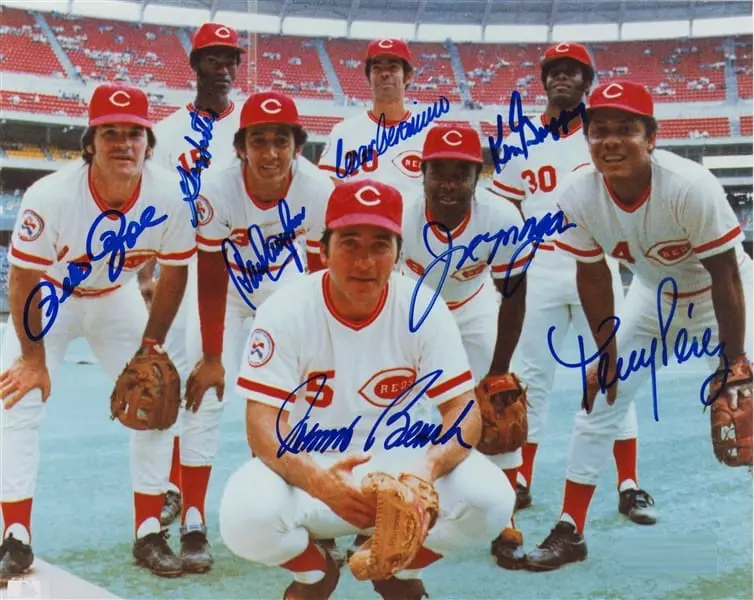
List Of Undefeated Postseason MLB Team

Why Are Baseball Contracts So Long?

FS1 ALDS Commentators And Announcers 2023

Designated for Assignment in Baseball: Key Rules and Strategies

In Major League Baseball, team rosters and player contracts are subject to constant change. One particular term that holds significant importance in this regard is “designate for assignment” (DFA).Understanding the DFA process and its implications on a player’s career is essential for anyone looking to learn more about the intricacies of Major League Baseball.
When a player’s contract is designated for assignment, he is removed from his team’s 40-man roster immediately. This action triggers a seven-day window within which the team must either trade the player or place him on irrevocable outright waivers.
The primary objective of the DFA process is to create flexibility for teams to manage their rosters while allowing them the opportunity to keep or release players based on performance or strategic considerations.
In general, a player that has been designated for assignment may find his career trajectory altered, as he could either end up being traded to another team, outrighted to a minor league team, or released from his contract entirely. As such, the DFA process plays a vital role in shaping the dynamics of professional baseball, impacting both teams and players alike.
Designate for Assignment Definition
Reasons for designating a player, waiver period, player outcomes, roster management, trade opportunities, notable dfa examples.
Designate for Assignment (DFA) is a contractual term used in Major League Baseball (MLB) when a team wants to remove a player from its 40-man roster.
This action allows the team to make room for a new player or provide flexibility in managing its roster. Once a player is designated for assignment, the team has seven days to decide the player’s fate, which could include trading, releasing, or outrighting the player to the minor leagues, among other options.
In addition to being removed from the 40-man roster, the player is also taken off the team’s active roster, meaning they cannot participate in any games during the seven-day period. The designated player’s contract remains in force, and they continue to receive their salary and benefits during this time.
To facilitate the player’s potential move to another team or the minor leagues, the player can be placed on waivers for a specified period. Waivers provide other MLB teams with the opportunity to claim the player and assume their contract. If multiple teams place a claim, the team with the weakest record in the player’s league is given priority. If the player is not claimed by any team during the waiver period, they can then be outrighted to the minor leagues, traded, or released.
However, if the player has accrued a specific amount of Major League service time, they may have the right to refuse an outright assignment to the minor leagues, opting instead for free agency.
There are various reasons a baseball team might opt to designate a player for assignment (DFA). One common reason is to make room on the 40-man roster for another player. The move allows the team to immediately remove a player from their roster and provides them with some roster flexibility.
Another reason for designating a player is due to their performance. If a player is experiencing a significant slump or has consistently failed to meet the team’s expectations, the DFA process can be implemented as a method to allow the player to refocus, find their form, or make adjustments while they are in the minor leagues.
Injuries can also be a factor. When a player sustains a serious injury and is unable to contribute to the team, it may be necessary to designate them for assignment to open a roster spot for a healthy replacement. Similarly, when a player who was previously on the injured list is ready to return to the team, the organization may need to DFA another player to make room.
Lastly, financial considerations can come into play. In some cases, a team might designate a player for assignment due to their contract, such as when a high-priced player is underperforming and the team wishes to move on without having to pay that player’s remaining salary. This could make DFA an option for teams who are trying to reduce payroll while still retaining some control.
DFA Process
The process of Designated for Assignment (DFA) in baseball involves removing a player from a team’s 40-man roster. This step provides teams with flexibility in managing their player rosters and creates opportunities for the player in question to find a new role within another team.
When a player is designated for assignment, the team has seven days to determine the next course of action. During this period, the player can be traded or placed on irrevocable outright waivers, allowing other teams to claim the player (MLB.com) .
There are several possible outcomes for a player who has been designated for assignment:
- Returned to the 40-man roster: The team can choose to reverse the decision and return the player to the 40-man roster
- Trade: The player can be traded to another team during the waiver period, allowing both teams to negotiate a mutually beneficial agreement.
- Waivers: If the player is placed on waivers and claimed by another team, the new team takes responsibility for the player’s contract.
- Release: The player is released from the team, effectively making them a free agent and able to negotiate a new contract with any team.
- Outright to the Minor Leagues: If the player clears waivers, meaning no teams claim the player, they can be outrighted from the 40-man roster into Minor League Baseball, allowing the player to continue their career within the organization.
The DFA process creates flexibility for teams to adjust their rosters as needed, while providing players with the opportunity to find new roles within the league.
Strategies and Implications
Designating a player for assignment (DFA) is a useful roster management tool in baseball. When a player is designated for assignment , they are immediately removed from the team’s 40-man roster, but their rights are retained by the team. This allows the team to explore different options within a seven-day window, such as trading the player or placing them on irrevocable outright waivers.
Utilizing the DFA process can help teams manage their roster more effectively by providing flexibility in making decisions. Teams may choose to designate a player for assignment if they need to clear roster space for an incoming player or if they believe the player is no longer a suitable fit for the team’s strategy. This process also provides teams with the opportunity to find appropriate solutions for both the team and the player, minimizing the risk of losing the player without receiving any return value.
When a player is designated for assignment, there are trade opportunities that may benefit the team. The player can be traded to another team within the seven-day window, allowing the original team to potentially receive assets in return. This can include other players, cash considerations, or a combination of both.
Trading a designated player provides teams with the possibility of acquiring additional resources that may be more aligned with their strategic goals or fill specific needs on the roster. It serves as a last resort for the team to recoup some value from the player before potentially losing them via waivers.
In summary, the designated for assignment process in baseball offers valuable roster management and trade opportunities for teams. By strategically using this tool, teams can optimize their roster composition and take advantage of potential trade returns to build a competitive team.
Throughout the history of Major League Baseball, many players have been designated for assignment (DFA). While some DFA cases are unremarkable, others involve notable players or have led to interesting outcomes. Here are a few prominent examples:
One such case involved former World Series MVP Pablo Sandoval who was designated for assignment by the Boston Red Sox in 2017. After experiencing a significant decline in performance and dealing with health issues, the Red Sox ultimately DFA’d Sandoval , eventually releasing him.
Another significant example is the 2018 DFA placement of four-time All-Star Adrian Gonzalez by the New York Mets. The first baseman struggled in his time with the Mets and was consequently designated for assignment , eventually released and then retiring.
Former Cy Young Award winner Tim Lincecum also experienced a notable DFA in 2016, when the Los Angeles Angels removed him from their 40-man roster due to poor performance. In this case, Lincecum cleared waivers and was outrighted to Triple-A before ultimately electing free agency later that year.
In summary, these notable DFA examples showcase the unpredictability and challenges faced by professional baseball players. The designated for assignment process is a reminder that no player is immune to changes in performance, injuries, or other factors that may lead to their removal from a team’s 40-man roster.

Home » Why Do MLB Players Get Designated for Assignment (DFA)?
Why Do MLB Players Get Designated for Assignment (DFA)?
Designated for Assignment (DFA) is a term used in Major League Baseball (MLB) that refers to the process of a team removing a player from their 40-man roster. This is done for various reasons, such as to make room for new players, to demote a player to the minor leagues, or to cut ties with a player who is not performing. In this article, we’ll take a look at why MLB players get designated for assignment and some of the implications of the process.
The Role of Contracts in the DFA Process
One of the primary reasons players are designated for assignment is due to a team’s need to make room on their 40-man roster. Teams must maintain a 40-man roster of players who are eligible to play in the major leagues, so if a team wants to add a new player they must first remove an existing one. This is often done by designating a player for assignment.
Additionally, teams can use the DFA process to get out of a contract they no longer want. MLB contracts are guaranteed, meaning that teams are obligated to pay a player the full value of their contract even if they are released. However, if a player is designated for assignment, the team is only obligated to pay a portion of the remaining salary. This is one of the main reasons why teams will opt to designate a player for assignment instead of simply releasing them.
Implications of Being Designated for Assignment
When a player is designated for assignment, they are placed on waivers for a period of seven to ten days. During this time, any other team can claim the player and add them to their roster. If the player is not claimed, they are then sent outright to the minor leagues or released.
If a player is sent to the minor leagues, they have the option to refuse the assignment and become a free agent. This can be beneficial to the player since they can explore the market and find a team that is a better fit.
Another implication of being designated for assignment is that it can have a negative effect on a player’s reputation. Players that are released or sent to the minors often struggle to find another job in the MLB, as teams are wary of taking on a player with a history of being designated for assignment.
Reasons Why Players Get Designated for Assignment
There are a variety of reasons why teams may choose to designate a player for assignment. Here are some of the most common:
1. Performance
The most common reason a player is designated for assignment is due to their performance. If a team feels that a player is no longer meeting their expectations or is not progressing as they should, they may opt to move on and replace them with a different player.
If a player suffers an injury that will keep them out for an extended period of time, a team may opt to designate them for assignment in order to free up a roster spot. This is often done with the intention of re-signing the player once they have fully recovered from their injury.
Teams may also opt to designate a player for assignment in order to free up money for other players. This is often done with highly paid veterans who are nearing the end of their contracts and are no longer playing at an elite level.
4. Personal Reasons
In some cases, teams may designate a player for assignment due to personal reasons. This could be due to a player’s attitude or off-field behavior, or simply because the team is looking to move in a different direction.
Designated for Assignment (DFA) is a term used in Major League Baseball that refers to the process of a team removing a player from their 40-man roster. Teams use the DFA process for various reasons, such as to make room for new players, to demote a player to the minor leagues, or to cut ties with a player who is not performing. This article has explored why MLB players get designated for assignment and some of the implications of the process.
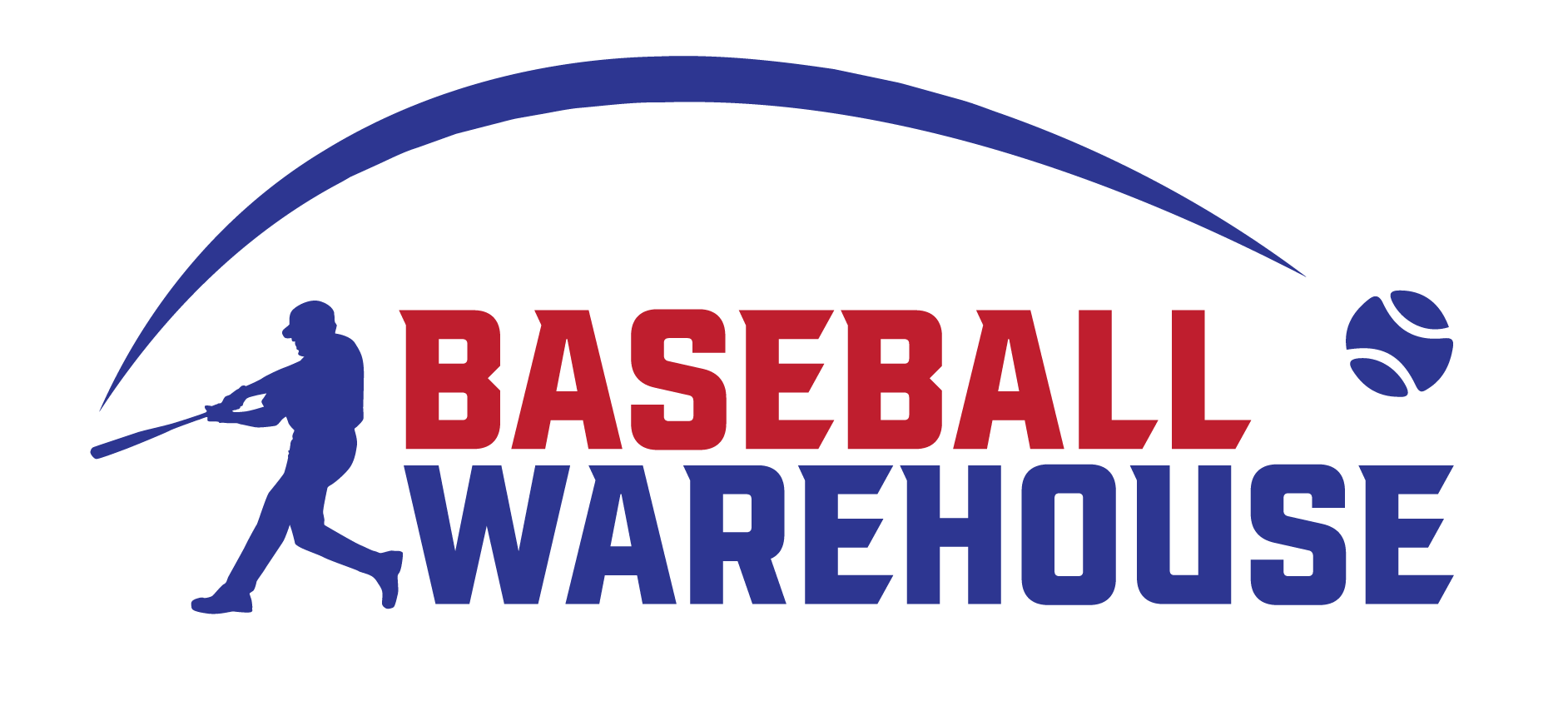
What does designated for assignment DFA mean in baseball?

Introduction
Quick Navigation
In every sport, rules are governing them. Baseball, as a sport, has its own rules and regulations guiding the game. These rules were put in place for players and officials to know what is to be done and what not to do in the game. These rules apply to every part of the game, from the equipment used in playing the game to how scores are counted. These rules help give the game a unified front and allow for a better understanding of the game. Most of the rules were created a long time ago and were later fine-tuned to fit into the modern-day context of the game. Having rules is a beautiful thing, as it helps solves a lot of knotted situations without much stress.
Know more: What is a save in baseball
There are certain terms and terminologies pertaining to different sports, likewise baseball. one of those terms in baseball includes the DFA. The DFA has only one meaning in baseball, which is designated for assignment. Knowing how to keep a score or a scorebook is not the only practice you need to know in baseball. There are certain terminologies you have to master and command before it can be said that you have the full knowledge of baseball. There are so many terminologies used in baseball, with each having different meanings. Terminologies such as balk, battery, bunt, count, cleanup, diamond, error flyball, and groundball, and a full count are common to baseball, and each has its meaning. However, out of all these terminologies, most people don’t understand the DFA; although, unlike the rest, it is not a term used during play, which is why it is not very popular amongst baseball enthusiasts. However, the full meaning of DFA in baseball will be explained to you as you continue reading.
Know more: How many player on a baseball team
DFA in Baseball
DFA In baseball stands for designated for assignment; this term is used when a player’s contract is designated for assignment. Once this occurs, the player is removed from the roster at once. When you hear the term DFA, some other terminologies accompany it; all these will be explained for better understanding.
- What is DFA in Baseball?: The term DFA as said earlier stands for designated for assignment; this term is used when the player’s contract to his club is designated for assignment. Once this occurs, the player is immediately removed from the forty-man roster of his club; within a week or ten days of this agreement, the player can be placed on irrevocable outright waivers or traded. To better understand this term, one needs to be familiar with the term waiver in baseball.
- What is a waiver?: A waiver is a form of permission granted to other teams in baseball, which allows them to proceed with a player move that will not be allowed normally by the rules of the game.
Checkout: How to hold a baseball bat
- Place player on waiver: After placing a player on DFA, the player can be claimed off waiver by another club. Once this club claims the player, he immediately joins their 40 man roster. At this point, the player can be sent to one of the clubs in the minor league. However, if the player can clear all waivers, he can be sent to the minor leagues or be released. If a player has played for about 3 to 5 years in the major league, the player must give his consent before being assigned to minor leagues. But in some cases, players withhold their consent. In this case, the club can either release the player or keep him on the roster of the major league. In both cases, the player will continue getting his pay under the terms of his agreement with the club.
- Trade the player: once a player is placed on DFA, the player may be traded. Some major team has been known to put their players on designated for assignment to increase the interest on such players, especially among teams not at the top of the waiver list. According to the waiver rule, other teams would have preferences in claiming a player. Also, under the five and ten rule, if a player has ten years experience in the major league, he cannot be traded without his consent.
- Release the player: If a player clears his waivers and is not traded, the players can be released from the team. Once the player is released, he becomes a free agent and can sign a new deal with any of the 30 major league teams with his present team inclusive.
Checkout the meaning of: Designated for Assignment in Basball
The designated for assignment is a terminology used for players that have been dropped from his team roster. Once a player is placed on DFA, the team releases the player or trades the player to another team in the major league. If it is a player with less than three years of experience in the major league, the player can be sent to one of the clubs in the minor league. However, in the case of a player with more than 5 or 10 years of experience in major league baseball, he cannot be traded or sent to the minor league without his consent. And if the player refuses to drop his consent, he is released and becomes a free agent and can end up still signing another contractual agreement with the team that just released him.
Related posts:
- What Does RBI Mean in Baseball
- What Does the K Mean In Baseball?
- What Does Era Mean In Baseball
- How Many Innings in a College Baseball Game

What Does DFA Mean In Baseball?
DFA stands for “Designated for Assignment,” a term used in the sport when a player’s contract is removed from his club’s 40-man roster. This move often occurs when a team wants to make room for a new player or needs to clear up space on the roster. In this article, we will dive deeper into what DFA means in baseball and why it is an important part of the game.
In this article...
What Does DFA Mean in Baseball?
DFA stands for “designated for assignment,” a term used in Major League Baseball to describe the process of removing a player from the 40-man roster. When a player is DFA’d, the team has ten days to either trade, release, or outright release the player to the minor leagues.
The DFA process is usually used when a team needs to make room on the 40-man roster for a new player or to free up space for a player returning from injury. It is also used when a team wants to remove a player who is not performing well or who has become a distraction.
When a player is DFA’d, he is immediately removed from the active roster, and the team can replace him with another player. The player is still on the team and is still paid his salary, but he cannot play in any games until his status is resolved.
If the player is traded or claimed off waivers within the ten-day period, he is removed from the DFA list, and the team that acquired him assumes his contract. If the player is not claimed or traded within the ten-day period, he can be outrighted to the minor leagues, where he will remain on the team’s payroll but will not count against the 40-man roster. You may read also the best youth baseball glove under $150
How many times can a player be optioned?
In Major League Baseball (MLB), there are rules regarding the number of times a player can be optioned to the minor leagues. An option year refers to the year in which a player is sent to the minor leagues while remaining on the 40-man roster.
Typically, a player has three option years, meaning he can be sent down to the minor leagues and called back up to the majors three times without being exposed to waivers. However, there are some exceptions to this rule. If a player has already used up all three of his option years and is sent down again, he must first clear waivers before being assigned to a minor league team
The Reason for Designated Assignments (DFAs) in Baseball
In baseball, Designated for Assignment (DFA) is a process by which a team can remove a player from its 40-man roster, thus freeing up a spot for another player. The DFA process allows a team to remove a player from the roster while giving them time to either trade the player or place them on the waiver. If the player clears waivers, the team can then outright the player to the minor leagues.
The main reason for DFA is to give teams more flexibility with their roster. Sometimes, a team may need to add a player to their roster quickly, and they need to free up a spot on the 40-man roster to do so. The DFA process allows them to remove a player without having to immediately release them or trade them.
Additionally, the DFA process can be beneficial to players as well. If a player is DFA’d, they have the opportunity to be claimed by another team, giving them a chance to continue their career at the major league level. Even if a player isn’t claimed off waivers, they can still be outrighted to the minor leagues and continue playing. You may read the guide on the best baseball cleats for ankle support
The Technicalities Around DFA in Baseball
Designated for assignment (DFA) is a technical term used in Major League Baseball (MLB) when a team wants to remove a player from its 40-man roster but cannot outright release him. This typically occurs when a team needs to make room for new player acquisition, either via trade or signing, and the player being designated for the assignment has not performed up to expectations.
40-Man Roster:
When a player is designated for assignment, he is immediately removed from the 40-man roster, but he is not immediately released. Instead, the player must be placed on waivers, giving all other MLB teams the opportunity to claim him. If no other team claims the player within 7 days, he is either released or outrighted to the minors, depending on the player’s contract status and the team’s decision.
If a team decides to outright a player to the minors, he must clear outright waivers first, which means that all other teams have the opportunity to claim him for a reduced price. If the player is claimed, his new team assumes responsibility for the remainder of his contract. If he clears waivers, he can either accept the outright assignment to the minors or become a free agent, in which case his original team is responsible for paying the remainder of his contract.
What Does it Mean to Option a Baseball Player?
To option a baseball player refers to the process of sending a player who is on a Major League Baseball (MLB) team’s 40-man roster down to its minor league system for a period of time. This option allows the player to continue playing and developing his skills in the minor leagues while freeing up a roster spot on the MLB team.
Each player typically has three option years, during which the team can send them up and down from the minors without exposing them to waivers. Optioning a player is a common strategy used by MLB teams to manage their roster and develop young players. You may check also the guide on the best baseball cleats for flat feet
In conclusion, “DFA” in baseball refers to the term “Designated for Assignment.” This is a process where a team removes a player from their 40-man roster and places them on waiver or outright releases them. This move allows the team to make room for another player on their roster. The DFA process is commonly used when a team wants to clear space for a new acquisition or when a player is not performing up to expectations. Understanding the language and terminology used in sports is essential for fans and professionals alike, and knowing the meaning of DFA is an important part of following baseball.
What is DFA in baseball terms?
DFA stands for “Designated for Assignment” in baseball. It is a move made by a team when they need to remove a player from their 40-man roster. The player is removed from the active roster and can be traded, released, or assigned to the minors if they clear waivers.
In Major League Baseball (MLB), there is no limit to the number of times a player can be optioned to the minor leagues in a single season. However, a player can only be optioned in three different seasons before being subjected to waivers if they are to be optioned again.
What does AA mean in baseball?
In baseball, AA stands for “Double-A” which is a level of professional play in Minor League Baseball (MiLB). It is considered to be the second-highest level of competition in the minor leagues and is one step below Triple-A. Players in Double-A are typically considered to be close to reaching the major leagues.
What does waivers mean in baseball?
In baseball, a waiver is permission granted by a team to release or assign a player to another team. Waivers are typically used to prevent a team from blocking a player’s opportunity to play for another team. Other teams can claim the waived player in a specific order, based on their position in the league standings.
Hi there! My name is Johnny Alvin, and I'm the proud founder of BaseballVisible.com, your one-stop destination for all things baseball. As a lifelong baseball enthusiast, I have always been passionate about the sport and all that it has to offer. Whether it's catching a game at the ballpark or watching it on TV, I never tire of the excitement and thrill that baseball brings.
With BaseballVisible.com, I have made it my mission to share my knowledge and passion for baseball with the world. Our website is dedicated to providing comprehensive guides, reviews, and tips that cover everything from the basics of the game to advanced strategies and techniques.
As an experienced player and coach, I understand the importance of having the right gear and equipment to play at your best. That's why we offer detailed reviews and recommendations for all kinds of baseball equipment, from gloves and bats to cleats and protective gear.
But baseball is more than just the gear. It's a game that requires skill, strategy, and teamwork, and we aim to provide resources that help players of all levels improve their game. Our guides cover everything from the fundamentals of hitting, fielding, and pitching to advanced tactics and techniques that can take your game to the next level.
At BaseballVisible.com, we are committed to providing the best possible resources for baseball players and enthusiasts. Whether you're a seasoned pro or just starting out, we hope you find our website helpful and informative. Thanks for visiting, and we look forward to being a part of your baseball journey!
Similar Posts

What is Written on Harley Quinn Baseball Bat?
Have you ever wondered about the enigmatic words adorning Harley Quinn’s iconic baseball bat? Prepare to be intrigued as we unveil the secret behind this striking yet cryptic message. Delving into the immersive world of Batman: Arkham City, we discover that the words on Harley Quinn’s bat are none other than the haunting lyrics of…

What Oil to Use to Break in a Baseball Glove?
There’s a certain magic in the air when you first lay hands on a brand-new baseball glove. The smell of fresh leather, the crisp sound it makes when you clench your fist, the anticipation of the many games it will see. But before you can make that game-winning catch, there’s an essential ritual every glove…

What Does E Mean In Baseball?
Baseball is a game of strategy, precision, and athleticism. From the crack of the bat to the roar of the crowd, the sport is filled with excitement and anticipation. However, as with any game, mistakes can happen. In baseball, these mistakes are recorded as “errors” and denoted by the letter “e” on the scoreboard. Errors…

How Many Baseball Games in a Season?
Are you curious about the number of baseball games in a season? If so, you’ve come to the right place. In this article, we’ll dive into the Major League Baseball (MLB) season and shed light on the total number of games played. Each of the 30 teams in the American League (AL) and National League…

Is Baseball Harder Than Softball?
Are you an avid baseball or softball fan wondering which sport is harder? Brace yourself for a bold statement: Softball is scientifically proven to be harder than baseball. Yes, you read that right! Despite popular belief, softball poses greater challenges to its players than baseball, and this isn’t just a matter of opinion. Various scientific…

How Should a Baseball Glove Close?
Are you an aspiring baseball player or a passionate fan looking to enhance your game? The way you close your baseball glove might seem like a small detail, but it can significantly impact your performance on the field. In this article, we’ll explore the key techniques to properly close a baseball glove, ensuring a snug…
Leave a Reply Cancel reply
Your email address will not be published. Required fields are marked *
Save my name, email, and website in this browser for the next time I comment.
The Designated for Assignment (DFA) Process in Major League Baseball: Implications, Procedures, and Examples

- Uncategorized

What does it mean to be designated for assignment?
To be designated for assignment in baseball means that a player has been removed from his team’s 40-man roster. This move is typically made when a team wants to make room for another player, or if the player’s performance has been disappointing or if he has become injured. Once a player is designated for assignment, the team has 7 days to trade him, release him, or place him on waivers. During this time, other teams have the opportunity to claim the player off waivers and assume his contract. If the player clears waivers, he can be assigned to the team’s minor league system or remain on the 40-man roster. Being designated for assignment can be a difficult and uncertain time for a player, as it often means he is at risk of losing his spot on the team and potentially even his career.
Why do teams designate players for assignment?
Teams designate players for assignment for a variety of reasons. The most common reason is to clear a roster spot for another player, either from their own minor league system or via a trade or free agent signing. Another reason could be due to a player’s poor performance, as a team may want to remove them from the active roster and give another player a chance to contribute. In some cases, a player may be designated for assignment if they become injured and the team needs to free up a roster spot for a healthy player. Finally, a team may designate a player for assignment if they are looking to trade the player and want to remove them from the active roster while negotiations are taking place. Regardless of the reason, being designated for assignment can be a difficult and uncertain time for a player, as their future with the team and in baseball is put into question.
What happens to a player who is designated for assignment?
When a player is designated for assignment, he is immediately removed from the team’s active roster and placed on the 40-man roster’s “designated for assignment” list. The team then has 7 days to make a decision on the player’s future. During this time, the team can trade the player, release him, or place him on waivers. If the player clears waivers, the team can choose to assign him to their minor league system or keep him on the 40-man roster. If another team claims the player off waivers, they assume the player’s contract and roster spot.
For the player who has been designated for assignment, this can be a stressful and uncertain time, as their future with the team and in baseball is up in the air. They may be traded to another team, released and become a free agent, or sent to the minors, where they will need to work their way back up to the majors. The DFA process can have a significant impact on a player’s career and earning potential, as well as their confidence and morale.
The difference between designated for assignment and outright assignment While the terms “designated for assignment” (DFA) and “outright assignment” may seem similar, there is a key difference between the two. DFA is the process by which a player is removed from his team’s 40-man roster and given a 7-day window for the team to trade him, release him, or place him on waivers. If the player is not claimed off waivers, he can be assigned to the minor leagues or kept on the 40-man roster. On the other hand, outright assignment is the process by which a player is removed from both the 25-man and 40-man rosters and sent directly to the minor leagues. There is no 7-day window for a team to make a decision, and the player does not need to clear waivers. In other words, DFA is a more flexible process that allows the team to potentially retain the player or trade him, while outright assignment is a more direct demotion to the minor leagues. The two terms are often used interchangeably, but it’s important to understand the differences between the two. The impact of designated for assignment on a player’s career and future opportunities Being designated for assignment can have a significant impact on a player’s career and future opportunities. If a player is claimed off waivers by another team, he may be given a fresh start and the opportunity to contribute at the major league level. However, if the player clears waivers and is sent to the minors, his future in baseball may be uncertain. DFA can also have financial implications for both the player and the team. If the player is released, he becomes a free agent and can sign with any team, but may not receive the same salary he had with his previous team. Additionally, if a team is unable to trade a player who has been designated for assignment, they may be responsible for paying a portion of the player’s salary. The DFA process can be emotionally challenging for players, as it can be difficult to see their careers and livelihoods put into question. However, some players have been able to bounce back from DFA and use the experience as motivation to improve and succeed at the major league level. Examples of notable players who have been designated for assignment Throughout baseball history, many notable players have been designated for assignment at some point in their careers. One example is David Ortiz, who was designated for assignment by the Minnesota Twins in 2002 before being released and signing with the Boston Red Sox, where he went on to become one of the greatest designated hitters of all time. Another example is Jose Bautista, who was designated for assignment by the Pittsburgh Pirates in 2004 before being picked up by the Toronto Blue Jays and transforming into a two-time MLB home run champion. More recently, Albert Pujols, a three-time MVP and 10-time All-Star, was designated for assignment by the Los Angeles Angels in 2021 before being picked up by the Los Angeles Dodgers. These players’ experiences illustrate that being designated for assignment does not necessarily mean the end of a player’s career, and that they can use the experience as motivation to succeed in the future. The role of waivers in the designated for assignment process Waivers play a crucial role in the DFA process. When a player is designated for assignment, he must be placed on waivers before he can be traded or outright released. Waivers give other teams in the league the opportunity to claim the player and assume his contract and roster spot. The waiver process is designed to promote competitive balance in the league by giving all teams an opportunity to claim players who have been designated for assignment, regardless of their place in the standings. However, the process can also be complex and unpredictable, as teams must weigh the potential benefits of claiming a player against the risks and costs associated with doing so. Waivers can be an especially important factor in the DFA process for players with larger contracts or for teams with limited payroll flexibility. In these cases, a player who clears waivers and is outright released may be more likely to be picked up by another team, as they would not be responsible for assuming the player’s full contract. How a player can appeal a DFA decision While it is rare for a player to successfully appeal a DFA decision, there are a few situations in which a player may have grounds for an appeal. For example, if a team designates a player for assignment due to an injury that was not disclosed or properly diagnosed, the player may be able to appeal the decision and potentially be reinstated on the team’s active roster. In order to appeal a DFA decision, the player must file a grievance with the Major League Baseball Players Association (MLBPA) within 45 days of the transaction. The appeal will then be heard by an independent arbitrator, who will review the evidence presented by both the player and the team before making a final decision. While the appeal process can be time-consuming and expensive, it can provide a player with an opportunity to challenge a DFA decision and potentially continue his career at the major league level. The potential financial implications of designated for assignment for both players and teams Designating a player for assignment can have significant financial implications for both the player and the team. If the player is claimed off waivers, the team may be responsible for paying a portion of the player’s salary or may be relieved of the obligation entirely. If the player clears waivers and is outright released, the team may still be responsible for paying the remainder of the player’s contract, depending on the terms of the agreement. For the player, being designated for assignment can have long-term financial implications as well. If the player is released and becomes a free agent, he may struggle to find a team willing to offer him a similar contract. Additionally, if the player is sent to the minors, he may be paid a lower salary than he was making at the major league level. Overall, the financial impact of DFA can be significant and is an important factor for both players and teams to consider when making decisions about roster moves. The designated for assignment process in relation to the MLB Collective Bargaining Agreement The DFA process is governed by the Major League Baseball Collective Bargaining Agreement (CBA), which outlines the rights and responsibilities of players and teams in relation to roster moves. The CBA includes provisions related to waivers, including the waiver claim process, which gives all teams in the league an opportunity to claim players who have been designated for assignment. The CBA also sets forth procedures for players to file grievances and challenge roster decisions, including DFA decisions, through the MLBPA. The CBA also sets minimum salary and service time requirements for players, which can impact a team’s decision to designate a player for assignment or keep him on the roster. Additionally, the CBA includes provisions related to arbitration, which can be used to resolve disputes between players and teams regarding contracts, salaries, and roster decisions. Overall, the DFA process is an important aspect of the MLB CBA, which governs many aspects of player contracts, salaries, and roster moves. Conclusion Being designated for assignment is a significant event in a player’s career that can have long-lasting implications. While the designated for assignment process is designed to give teams flexibility in managing their rosters, it can also be challenging for players who may be faced with uncertainty about their future. Waivers and financial considerations can also play important roles in the DFA process, and the procedures outlined in the MLB Collective Bargaining Agreement provide a framework for resolving disputes and ensuring fair treatment of players. Ultimately, the DFA process is an important aspect of the MLB landscape that requires careful consideration by teams and players alike. FAQs
1. what happens to a player who is designated for assignment.
A player who is designated for assignment is removed from his team’s 40-man roster and can be placed on waivers or outright released. If the player is not claimed by another team within the designated time frame, he can be sent to the minor leagues or become a free agent.
2. What is the difference between DFA and outright assignment?
DFA refers to the process of designating a player for assignment and placing him on waivers, while outright assignment refers to the process of removing a player from the 40-man roster and sending him to the minor leagues without passing through waivers.
3. How can a player appeal a DFA decision?
days of the transaction, and an independent arbitrator will review the evidence before making a final decision.
4. What are the financial implications of DFA for players and teams?
DFA can have significant financial implications for both players and teams. Teams may be responsible for paying a portion of the player’s salary or may be relieved of the obligation entirely if the player is claimed off waivers. For the player, being designated for assignment can impact his salary and long-term earning potential.
5. What is the role of waivers in the DFA process?
Waivers are used to give all teams in the league an opportunity to claim players who have been designated for assignment. If the player is claimed, the team claiming him assumes the responsibility for his contract. If the player clears waivers, he can be outright released or sent to the minor leagues.
Total Assignment Help Incase, you are looking for an opportunity to work from home and earn big money. TotalAssignmenthelp Affiliate program is the best choice for you.
Do visit : https://www.totalassignment.com/affiliate-program for more details
Total Assignment help is an assignment help Online service available in 9 countries. Our local operations span across Australia, US, UK, South east Asia and the Middle East. With extensive experience in academic writing, Total assignment help has a strong track record delivering quality writing at a nominal price that meet the unique needs of students in our local markets.
We have specialized network of highly trained writers, who can provide best possible assignment help solution for all your needs. Next time you are looking for assignment help, make sure to give us a try.
Looking for Assignment Help from Top Experts ?
Get the best Assignment Help from leading experts from the field of academics with assured onetime, 100% plagiarism free and top Quality delivery.
Related posts
Understanding the difference between basic vs applied research with the aid of examples.

Examining How To Write The Perfect Hook For Your Assignment

Get Expert Advice On How To Develop Yourself As A Human Resource Practitioner
Leave a reply cancel reply.
Your email address will not be published. Required fields are marked *
Save my name, email, and website in this browser for the next time I comment.
Designated for assignment
- View history
Designated for assignment is a contractual term used in Major League Baseball . When a player is designated for assignment, he is immediately removed from the club's 40-man roster . This gives the club 10 days to decide what to do with the player while freeing up a roster spot for another transaction, if needed. After designating a player for assignment, the club must make one of the following contractual moves.
Place the player on waivers [ ]
Typically a player is placed on waivers after being designated for assignment for the purpose of outrighting him to one of the club's minor league teams. However, a player must clear waivers (that is, no other team may place a waiver claim on the player) to be sent to a minor league team. Also, if the player has five or more full years of major league service, he must give consent to be assigned to the minors. If the player withholds consent, the team must either release him or keep him on the major league roster. In either case, the player must continue to be paid under the terms of his contract.
Trade the player [ ]
Once a player is designated for assignment, he may be traded. Some teams have been known to designate players for assignment to increase interest in the player, especially among teams that are not at the top of the list for waivers. For example, in May 2006, Rangers reliever Brian Shouse was designated for assignment, and was traded to the Milwaukee Brewers 4 days later. The Brewers could have waited until Shouse was placed on waivers so they would not have had to give up a player in a trade, but according to the waiver rules , the other 13 AL teams would have preference in claiming him. Also, under the "five and ten rule," if a player has ten years of Major League service, the last five of which with his current team, he cannot be traded without his consent.
Release the player [ ]
If a player is not traded, and clears waivers, he may be released from the team. The player is then a free agent and is able to sign with any of the 30 Major League teams, including the team that just released him. The team that releases him is responsible for the salary the player is owed, less what he is paid by the team that signs him.

The Baseball Cube
Designated for assignment.
- High School
- Other Topics
- Research Tools
Player Transactions
- Manual Filter: Single-click a row to highlight in orange. Click FILTER ROWS button to show only those rows in the grid
- Quick-Filter: Double-Click on a cell value to filter the grid on rows that have same value in same column. Click a statistic to view all values equal or higher
- Select Rows: Single-click rows to select multiple rows for future action or visibility.
- Hide Rows: Click the` minus sign in the first column to hide the row in the grid.
- Restore Rows: Once rows are filtered, click RESTORE ROWS to show all rows once again
- Sort: Click a column in the first header row to sort data by values in that column. Click again to reverse the original sort. Some cells have custom sort keys that will sort them logically instead of alphanumerically.
- Compare/Analyze: Click multiple rows for players of interest. In addition to filtering, you can quickly COMPARE player stats or use the MULTI-PLAYER STAT VIEWER to view multiple player cards on the same page.
- Export to CSV: Click CSV to convert the full grid into a comma-delimeted display. From there, you can copy/paste to another application.


IMAGES
COMMENTS
Designate for Assignment (DFA) Definition. When a player's contract is designated for assignment -- often abbreviated "DFA" -- that player is immediately removed from his club's 40-man roster. Within seven days of the transaction (had been 10 days under the 2012-16 Collective Bargaining Agreement), the player can either be traded or placed on ...
If a team claims a player that has been designated for assignment, and that player still has minor league options left, the team can choose to use one to send the player to the minors, so long as ...
Designated for assignment ( DFA) is a contractual term used in Major League Baseball (MLB). [2] A player who is designated for assignment is immediately removed from the team's 40-man roster, after which the team must, within seven days, [a] return the player to the 40-man roster, place the player on waivers, trade the player, release the ...
A team can designate a player due to various reasons. It can be for changing the game strategy and tactics or trying to strengthen the team. Here are the most common reasons why a baseball designates a player for assignment: Performance issues: Performance reason is the primary reason for DFA. If a player fails to perform well and does not meet ...
Mark Faller, Arizona Republic. Thu, Sep 7, 2023 · 3 min read. The Arizona Diamondbacks designated Nick Ahmed for assignment after Wednesday's 12-5 win over the Colorado Rockies. Ahmed, the ...
Designated for assignment is a term unique to Major League Baseball ~ and unrelated to anything else. What does this terminology, known commonly as DFA, mean? ... Designated for assignment refers to a player's contract, and it means the team will immediately remove that player from its 40-man roster. For MLB fans, it means you will no longer ...
Designated for assignment (DFA) is a term used in baseball to describe a move by a team to remove a player from its active roster. The reasons why players get DFA can vary, but the most common reasons include injury, underperformance, and roster considerations. The implications of being DFA'd can be significant for a player's career and the ...
In order to take someone off the 40-man roster, they must be designated for assignment. MLB.com explains the process: "When a player's contract is designated for assignment — often abbreviated ...
DFA is short for Designated for Assignment and is a contractual term used in the baseball realm. Essentially, it refers to when a player is eliminated from a team's 40-man roster and placed on waivers for other teams to claim. ... Most recently, renowned player Alber Pujols was designated for assignment by the Angels, stunning many fans and ...
Also known as DFA, "designated for assignment" is a procedure in baseball where one team removes a player from the 40-man roster. However, it's not the same as an out-and-out release thanks to the seven-day limit. Within these seven days, a Major League Baseball team must do one of the following: Return the player to the 40-man roster (a ...
DFA means Designated for Assignment. When a player falls into this term, the team will immediately remove him from the 40-man roster. However, the team can replace that player with another one to fulfill its 40-player roster. One crucial thing I should mention, DFA does not mean out-and-out release.
Here's a look at the MLB designated for assignment process. The Arizona Diamondbacks designated pitcher Madison Bumgarner for assignment on Thursday after his latest rough outing on Wednesday ...
Designated For Assignment is a baseball term used in MLB which means the process of removing a player from the team roster. When a baseball player is designated for assignment, he becomes ineligible to play on the Major League team for at least seven days until his team makes a judgment on what to do with the player. To reach a definitive ...
Designate for Assignment Definition. Designate for Assignment (DFA) is a contractual term used in Major League Baseball (MLB) when a team wants to remove a player from its 40-man roster. This action allows the team to make room for a new player or provide flexibility in managing its roster. Once a player is designated for assignment, the team ...
Term Definition: designated for assignment Definition. Said of a player whose team opens a roster spot while waiting for the player to clear waivers. The team must trade or release him within ten days or reassign him (if he accepts) to a minor-league team within seven days. Since there are certain situations in which a team needs a player's ...
Conclusion. Designated for Assignment (DFA) is a term used in Major League Baseball that refers to the process of a team removing a player from their 40-man roster. Teams use the DFA process for various reasons, such as to make room for new players, to demote a player to the minor leagues, or to cut ties with a player who is not performing.
The term DFA as said earlier stands for designated for assignment; this term is used when the player's contract to his club is designated for assignment. Once this occurs, the player is immediately removed from the forty-man roster of his club; within a week or ten days of this agreement, the player can be placed on irrevocable outright ...
Rachael Millanta @rachaelmillanta Jul 07, 2023, 7:46 AM. If a player is designated for assignment, he is removed from the 40-man roster. The team has seven days to trade the player or place him on outright waivers. Like all professional sports, baseball is a game of amazing highs and, for many, some not-so-amazing lows.
DFA stands for "designated for assignment," a term used in Major League Baseball to describe the process of removing a player from the 40-man roster. When a player is DFA'd, the team has ten days to either trade, release, or outright release the player to the minor leagues. The DFA process is usually used when a team needs to make room on ...
For the player, being designated for assignment can have long-term financial implications as well. If the player is released and becomes a free agent, he may struggle to find a team willing to offer him a similar contract. Additionally, if the player is sent to the minors, he may be paid a lower salary than he was making at the major league ...
Designated for assignment is a contractual term used in Major League Baseball. When a player is designated for assignment, he is immediately removed from the club's 40-man roster. This gives the club 10 days to decide what to do with the player while freeing up a roster spot for another transaction, if needed. After designating a player for assignment, the club must make one of the following ...
Players who are currently removed from the 40-man roster and waiting for assignment, trade or release. The Transactions Research provides you with ability to search through pro player transactions since 2012. To access this tool and minor league transactions, subscribe to PREMIUM About Transactions data
A player is designated for assignment when his team wants to replace him on the active roster and he is out of options. The team thus announces its wish to send the player to the minor leagues and places his name on waivers. If the player is claimed, a trade may be worked out between the two teams. If the player is unclaimed, he can either ...